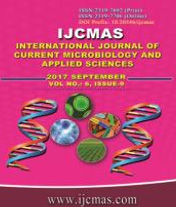


 National Academy of Agricultural Sciences (NAAS)
National Academy of Agricultural Sciences (NAAS)

|
PRINT ISSN : 2319-7692
Online ISSN : 2319-7706 Issues : 12 per year Publisher : Excellent Publishers Email : editorijcmas@gmail.com / submit@ijcmas.com Editor-in-chief: Dr.M.Prakash Index Copernicus ICV 2018: 95.39 NAAS RATING 2020: 5.38 |
The field experiment were conducted at Research Farm of CCS Haryana Agricultural University, Hisar, India (29º10’N latitude, 75º46’E longitude and 215.2 M altitude) during Rabi season of 2010-11 and 2011-12. The experiment was laid out in split plot design with four levels of irrigations (Io– no irrigation, I1-one irrigation at 45 DAS, I2-two irrigations at 45 and 85 DAS and I3- three irrigations at 45, 85 and 105 DAS) in main plot and three genotypes (V1- RD 2552, V2 - BH 902 and V3- DWRUB 52) in sub plots with three replications. On the basis of two years pooled data revealed that soil moisture stress causes low grain as well as straw yield, by inducing low 1000-grain weight and number of tillers m-2. The grain yield improvement in barley with three irrigation levels was 70.5 percent over no irrigation. Test weight, effective tillers, grain and straw yield were significantly affected by irrigation levels. Among highest grain yield was recorded under DWRUB 52 and BH 902 during 2010-11 and 2011-12, respectively. The study of correlation coefficients revealed that based on TOL and SSI, RD 2552 was found as most drought sensitive genotype. MP, STI, GMP, SSI and HARM had the most significant correlation with grain yield.
 |
 |
 |
 |
 |